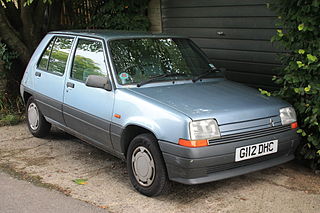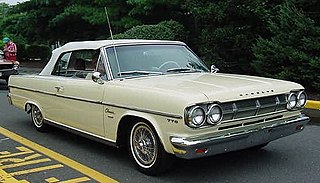Spyker or Spijker was a Dutch carriage, automobile and aircraft manufacturer, started in 1880 by blacksmiths Jacobus and Hendrik-Jan Spijker. Originally located in Hilversum, the company relocated to Trompenburg, Amsterdam in 1898.

The Renault 5 is a five-passenger, three or five-door, front-engine, front-wheel drive hatchback supermini manufactured and marketed by the French automaker Renault over two generations: 1972–1985 and 1984–1996. The R5 was marketed in the US and Canada as Le Car, from 1976 until 1983. Renault marketed a four-door sedan variant, the Renault 7, manufactured from 1974 until 1984 in Spain by Renault's subsidiary FASA-Renault and exported to select markets.

The Renault 9 and Renault 11 are small family cars produced by the French manufacturer Renault from 1981–1988 in saloon and hatchback configurations — both were styled by the French automobile designer, Robert Opron.

The Renault Laguna is a large family car that was manufactured and marketed by Renault for 21 years in three body styles: hatchback, coupé, and estate. The first generation Laguna was launched in 1994, the second generation was introduced in 2000, and the third generation was built from October 2007 until 2015.

A W12 engine is a twelve-cylinder piston engine where either three banks of four cylinders, or four banks of three cylinders are arranged in a W configuration around a common crankshaft.

The Renault Fuego is a sport hatchback that was manufactured and marketed by Renault from 1980 to 1986, replacing the Renault 15 and 17 coupés of the 1970s.

A phaeton is a style of open automobile without any fixed weather protection, which was popular from the 1900s until the 1930s. It is an automotive equivalent of the horse-drawn fast, lightweight phaeton carriage.

The Spyker C8 is a sports car produced by the Dutch automaker Spyker Cars since 2000. The design takes visual cues from the 1999 Spyker Silvestris V8 concept car but with changes to the proportions.

The Rambler Classic is an intermediate sized automobile that was built and sold by American Motors Corporation (AMC) from the 1961 through 1966 model years. The Classic took the place of the Rambler Six and Rambler Rebel V-8 names, which were retired at the end of the 1960 model year.

The Chrysler Phaeton was a four-door convertible sedan concept car built by Chrysler in 1997.

The WiLL brand was a marketing approach shared by a small group of Japanese companies who decided to offer products and services that focused on a younger demographic from August 1999 until July 2004 in Japan. The companies that participated were the Kao Corporation, Toyota, Asahi Breweries, Panasonic, Kinki Nippon Tourist Company, Ltd, Ezaki Glico Candy, and Kokuyo Co., Ltd.. Toyota also engaged in a similar "youth oriented" approach in North America, with the Project Genesis program. This selective marketing experiment reflected a Japanese engineering philosophy called Kansei engineering, which was used by other Japanese companies. All products were listed online at "willshop.com".

The Renault Mégane Renault Sport is a series of high-performance hatchback models based on the Renault Mégane, produced since 2004 by the high-performance subsidiary company Renault Sport for its parent company Alpine, a subsidiary of Renault. The Mégane RS won awards such as "Best hot hatch" from What car? (2010–2014), "Highest placed non-supercar" in Evo's annual Car of the Year test 2011 and "Best hot hatch" from Top Gear.

The Spyker C12 Zagato is a limited edition, all-aluminium, mid-engine/rear-drive exotic luxury sports car from Dutch automobile manufacturer Spyker. It is based on the C12 platform, alongside the Spyker designed C12 La Turbie which debuted the previous year, and features a unique body designed with help from Italian design house Zagato.

The Dacia Duster is a family of automobiles produced and marketed jointly by the French manufacturer Renault and its Romanian subsidiary Dacia since 2010. It is currently in its second generation, launched in the autumn of 2017. It is marketed as the Renault Duster in certain markets such as Latin America, Russia, Ukraine, Asia, the Middle East, South Africa, and New Zealand. The first generation was rebadged and restyled as the Nissan Terrano in CIS countries and India. It was introduced in March 2010, and is the third model of the Dacia brand based on the Logan platform, after the Sandero.

The Monaquatre was a small family car assembled by Renault between 1931 and 1936. It used a conventional front-engine, rear-wheel-drive configuration and was powered by a four-cylinder water-cooled engine.

The Nissan Juke is a subcompact crossover SUV (B-segment) produced by the Japanese car manufacturer Nissan since 2010. Debuted as a production vehicle at the 2010 Geneva Motor Show in March, it was introduced to North America at the 2010 New York International Auto Show to be sold for the 2011 model year, and it currently slots below the compact Qashqai.

The Renault Twizy is a two-seat electric microcar designed and marketed by Renault. It is classified in Europe as either a light or heavy quadricycle depending on the output power, which is either 4 kW (5.4 hp) for the 45 model or 13 kW (17 hp) for the 80 model, both names reflecting its top speed in km/h. Originally manufactured in Valladolid, Spain, production was moved to Busan in South Korea in March 2019 to meet increased demand in Asia. In July 2023 it was announced that production of the Twizy was to end in September 2023; it is to be replaced by the new Mobilize Duo.

The Lanchester Thirty-Eight was manufactured from 1910 to 1914 by the Lanchester Motor Company, located in Birmingham, England.
Rétrospectives Automobiles Miniatures was a French manufacturing company that made diecast scale model collector vehicles mostly of classic French automobiles in 1:43 scale. The acronym was seen on packaging without the periods between the letters of the acronym, but on some of the vehicle bases with the punctuation. "J.M.K." was a further acronym that stood for the three founding members of the company: M. Jarry, Henri Malartre and M. Koch. Though the models were often known simply as RAMI, the full name of the company was RAMI by J.M.K.
The NSU pipe 15/24 PS was a car which NSU built in the years 1906 to 1910 under license of the Belgian automobile manufacturer Pipe. The 15/24 PS was the successor of the NSU-Pipe 34 PS, and, like it, was targeted at the upper middle class market.

















